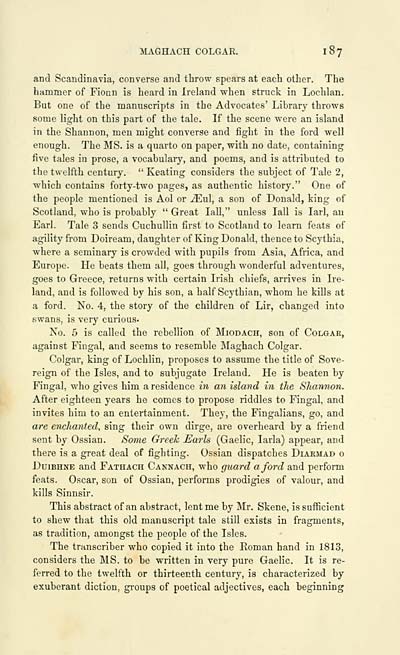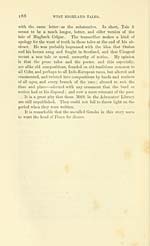Download files
Complete book:
Individual page:
Thumbnail gallery: Grid view | List view

MAGHACH COLGAR. 1 87
and Scandinavia, converse and throw spears at each other. The
hammer of Fioan is heard in Ireland when struck in Lochlan.
But one of the manuscripts in the Advocates' Library throws
some light on this part of the tale. If the scene were an island
in the Shannon, men might converse and fight in the ford well
enough. The MS. is a quarto on paper, with no date, containing
five tales in prose, a vocabulary, and poems, and is attributed to
the twelfth century. " Keating considers the subject of Tale 2,
which contains forty-two pages, as authentic history." One of
the people mentioned is Aol or ^ul, a son of Donald, king of
Scotland, who is probably " Great lall," unless lall is larl, au
Earl. Tale 3 sends Cuchullin first to Scotland to learn feats of
agility from Doiream, daughter of King Donald, thence to Scythia,
where a seminary is crowded with pupils from Asia, Africa, and
Europe. He beats them all, goes through wonderful adventures,
goes to Greece, returns with certain Irish chiefs, arrives in Ire-
land, and is followed by his son, a half Scythian, whom he kills at
a ford. No. 4, the story of the children of Lir, changed into
swans, is very curious.
No. 5 is called the rebellion of Miodach, son of Colgae,
against Fingal, and seems to resemble Maghach Colgar.
Colgar, king of Lochlin, proposes to assume the title of Sove-
reign of the Isles, and to subjugate Ireland. He is beaten by
Fingal, who gives him a residence i?i an island in the Shannon.
After eighteen years he comes to propose riddles to Fingal, and
invites him to an entertainment. They, the Fingalians, go, and
are enchanted, sing their own dirge, are overheard by a friend
sent by Ossian. Some Greeh Earls (Gaelic, larla) appear, and
there is a great deal of fighting. Ossian dispatches Diarmad o
DuiBHNE and Fathach Cannach, who guard a ford and perform
feats. Oscar, son of Ossian, performs prodigies of valour, and
kills Sinnsir.
This abstract of an abstract, lent me by Mr. Skene, is sufficient
to shew that this old manuscript tale still exists in fragments,
as tradition, amongst the people of the Isles.
The transcriber who copied it into the Koman hand in 1813,
considers the MS. to be written in very pure Gaelic. It is re-
ferred to the twelfth or thirteenth century, is characterized by
exuberant diction, groups of poetical adjectives, each beginning
and Scandinavia, converse and throw spears at each other. The
hammer of Fioan is heard in Ireland when struck in Lochlan.
But one of the manuscripts in the Advocates' Library throws
some light on this part of the tale. If the scene were an island
in the Shannon, men might converse and fight in the ford well
enough. The MS. is a quarto on paper, with no date, containing
five tales in prose, a vocabulary, and poems, and is attributed to
the twelfth century. " Keating considers the subject of Tale 2,
which contains forty-two pages, as authentic history." One of
the people mentioned is Aol or ^ul, a son of Donald, king of
Scotland, who is probably " Great lall," unless lall is larl, au
Earl. Tale 3 sends Cuchullin first to Scotland to learn feats of
agility from Doiream, daughter of King Donald, thence to Scythia,
where a seminary is crowded with pupils from Asia, Africa, and
Europe. He beats them all, goes through wonderful adventures,
goes to Greece, returns with certain Irish chiefs, arrives in Ire-
land, and is followed by his son, a half Scythian, whom he kills at
a ford. No. 4, the story of the children of Lir, changed into
swans, is very curious.
No. 5 is called the rebellion of Miodach, son of Colgae,
against Fingal, and seems to resemble Maghach Colgar.
Colgar, king of Lochlin, proposes to assume the title of Sove-
reign of the Isles, and to subjugate Ireland. He is beaten by
Fingal, who gives him a residence i?i an island in the Shannon.
After eighteen years he comes to propose riddles to Fingal, and
invites him to an entertainment. They, the Fingalians, go, and
are enchanted, sing their own dirge, are overheard by a friend
sent by Ossian. Some Greeh Earls (Gaelic, larla) appear, and
there is a great deal of fighting. Ossian dispatches Diarmad o
DuiBHNE and Fathach Cannach, who guard a ford and perform
feats. Oscar, son of Ossian, performs prodigies of valour, and
kills Sinnsir.
This abstract of an abstract, lent me by Mr. Skene, is sufficient
to shew that this old manuscript tale still exists in fragments,
as tradition, amongst the people of the Isles.
The transcriber who copied it into the Koman hand in 1813,
considers the MS. to be written in very pure Gaelic. It is re-
ferred to the twelfth or thirteenth century, is characterized by
exuberant diction, groups of poetical adjectives, each beginning
Set display mode to: Large image | Transcription
Images and transcriptions on this page, including medium image downloads, may be used under the Creative Commons Attribution 4.0 International Licence unless otherwise stated. ![]()
| Early Gaelic Book Collections > J. F. Campbell Collection > Popular tales of the West Highlands > Volume 2 > (205) |
|---|
| Permanent URL | https://digital.nls.uk/81419521 |
|---|
| Description | Volume II. |
|---|---|
| Shelfmark | Cam.2.g.4(2) |
| Attribution and copyright: |
|
| Description | Orally collected with a translation by J.F. Campbell. |
|---|---|
| Shelfmark | Cam.2.g.4(1-4) |
| Additional NLS resources: | |
| Description | Volumes from a collection of 610 books rich in Highland folklore, Ossianic literature and other Celtic subjects. Many of the books annotated by John Francis Campbell of Islay, who assembled the collection. |
|---|
| Description | Selected items from five 'Special and Named Printed Collections'. Includes books in Gaelic and other Celtic languages, works about the Gaels, their languages, literature, culture and history. |
|---|

